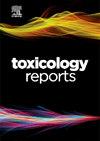Non-steroidal anti-inflammatory drugs and oxidative stress biomarkers in fish: a meta-analytic review
Q1 Environmental Science
引用次数: 0
Abstract
Drug residues have been detected in aquatic environments around the world and non-steroidal anti-inflammatory drugs (NSAIDs) are one of the most used classes. Therefore, it is important to verify the physiological effects of these products on exposed non-target organisms such as fish. Through a meta-analytic review, we evaluated the effects of NSAIDs on oxidative stress biomarkers in fish. Overall, Diclofenac was the most frequently tested drug in the systematically selected studies while acute and hydric exposure types were the most prevalent among these studies. The meta-analysis revealed that (1) chronic and subchronic exposures to NSAIDs decreased catalase (CAT) activity, and acute exposure increased glutathione peroxidase (GPx) activity; (2) hydric exposure increased GPx activity; (3) exposure to low concentrations of NSAIDs increased GPx and superoxide dismutase (SOD) activity; (4) Paracetamol exposure increased GPx and SOD activity and lipid peroxidation levels, but reduced glutathione S-transferase (GST) activity; (5) Diclofenac exposure increased GPx activity. In conclusion, our results demonstrated that fish are sensitive to NSAIDs exposure presenting significant alterations in oxidative stress biomarkers, especially in the GPx enzyme. This enzyme exhibits strong potential as a biomarker of NSAIDs exposure in fish. Paracetamol stood out as the NSAID that altered the largest number of oxidative stress biomarkers, drawing attention to its risk to fish. In contrast, ibuprofen did not change the biomarkers evaluated. These data demonstrate the important impact of emerging contaminants such as NSAIDs on aquatic organisms and the need for strategies to mitigate these effects.
非甾体抗炎药和鱼的氧化应激生物标志物:荟萃分析综述
在世界各地的水生环境中都检测到药物残留,非甾体抗炎药(NSAIDs)是使用最多的一类药物。因此,验证这些产品对暴露的非靶生物(如鱼类)的生理影响是很重要的。通过荟萃分析,我们评估了非甾体抗炎药对鱼类氧化应激生物标志物的影响。总体而言,在系统选择的研究中,双氯芬酸是最常见的测试药物,而急性和水合暴露类型在这些研究中最为普遍。荟萃分析显示(1)慢性和亚慢性暴露于非甾体抗炎药会降低过氧化氢酶(CAT)活性,急性暴露会增加谷胱甘肽过氧化物酶(GPx)活性;(2)水分暴露使GPx活性升高;(3)低浓度非甾体抗炎药使GPx和超氧化物歧化酶(SOD)活性升高;(4)对乙酰氨基酚暴露增加GPx和SOD活性及脂质过氧化水平,但降低谷胱甘肽s -转移酶(GST)活性;(5)双氯芬酸暴露使GPx活性升高。总之,我们的研究结果表明,鱼类对非甾体抗炎药暴露敏感,氧化应激生物标志物,特别是GPx酶发生了显著变化。该酶作为非甾体抗炎药暴露的生物标志物具有很强的潜力。扑热息痛作为一种改变氧化应激生物标志物数量最多的非甾体抗炎药,引起了人们对其对鱼类风险的关注。相比之下,布洛芬没有改变评估的生物标志物。这些数据证明了新兴污染物如非甾体抗炎药对水生生物的重要影响,以及减轻这些影响的策略的必要性。
本文章由计算机程序翻译,如有差异,请以英文原文为准。
求助全文
约1分钟内获得全文
求助全文
来源期刊

Toxicology Reports
Environmental Science-Health, Toxicology and Mutagenesis
CiteScore
7.60
自引率
0.00%
发文量
228
审稿时长
11 weeks
 求助内容:
求助内容: 应助结果提醒方式:
应助结果提醒方式:


